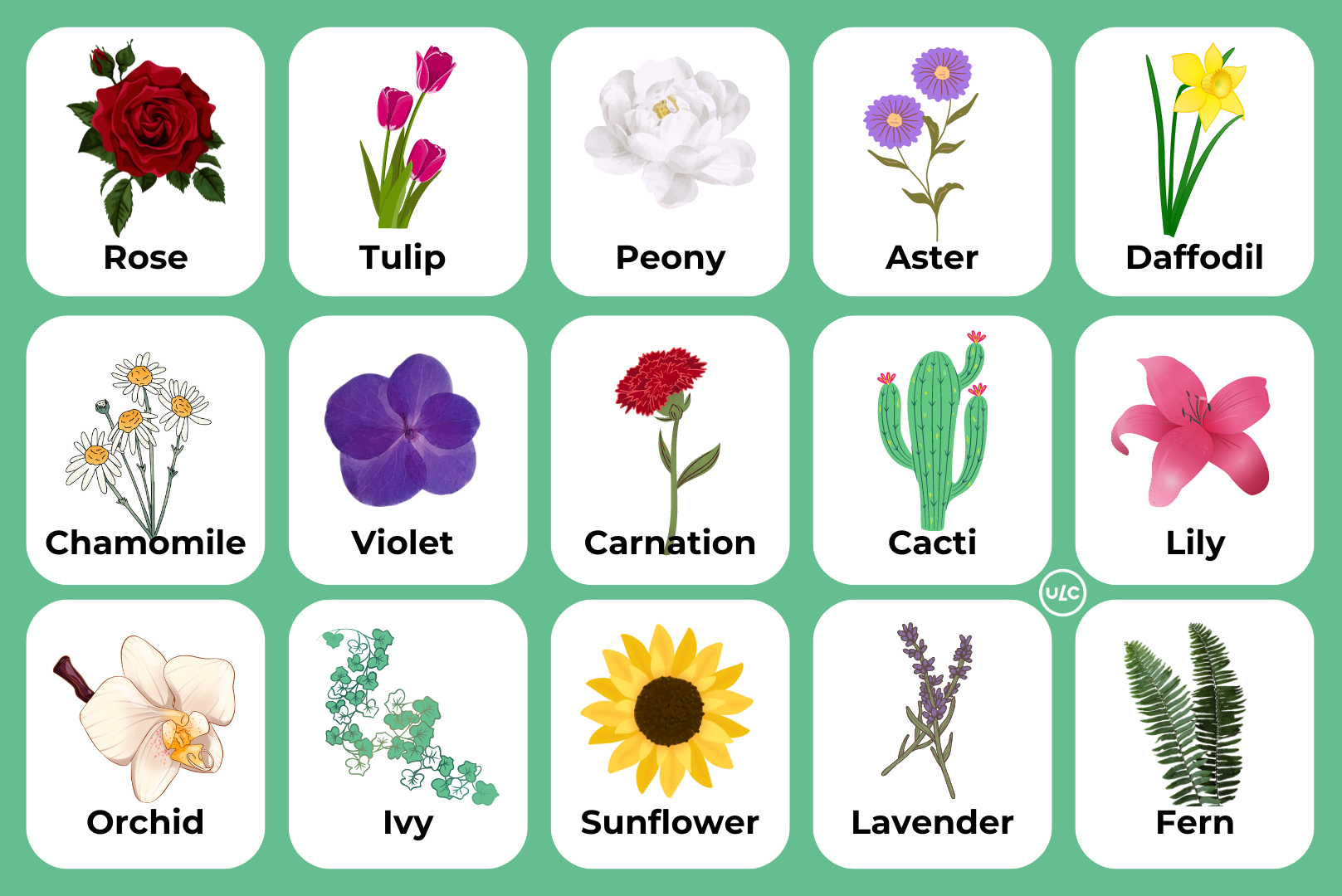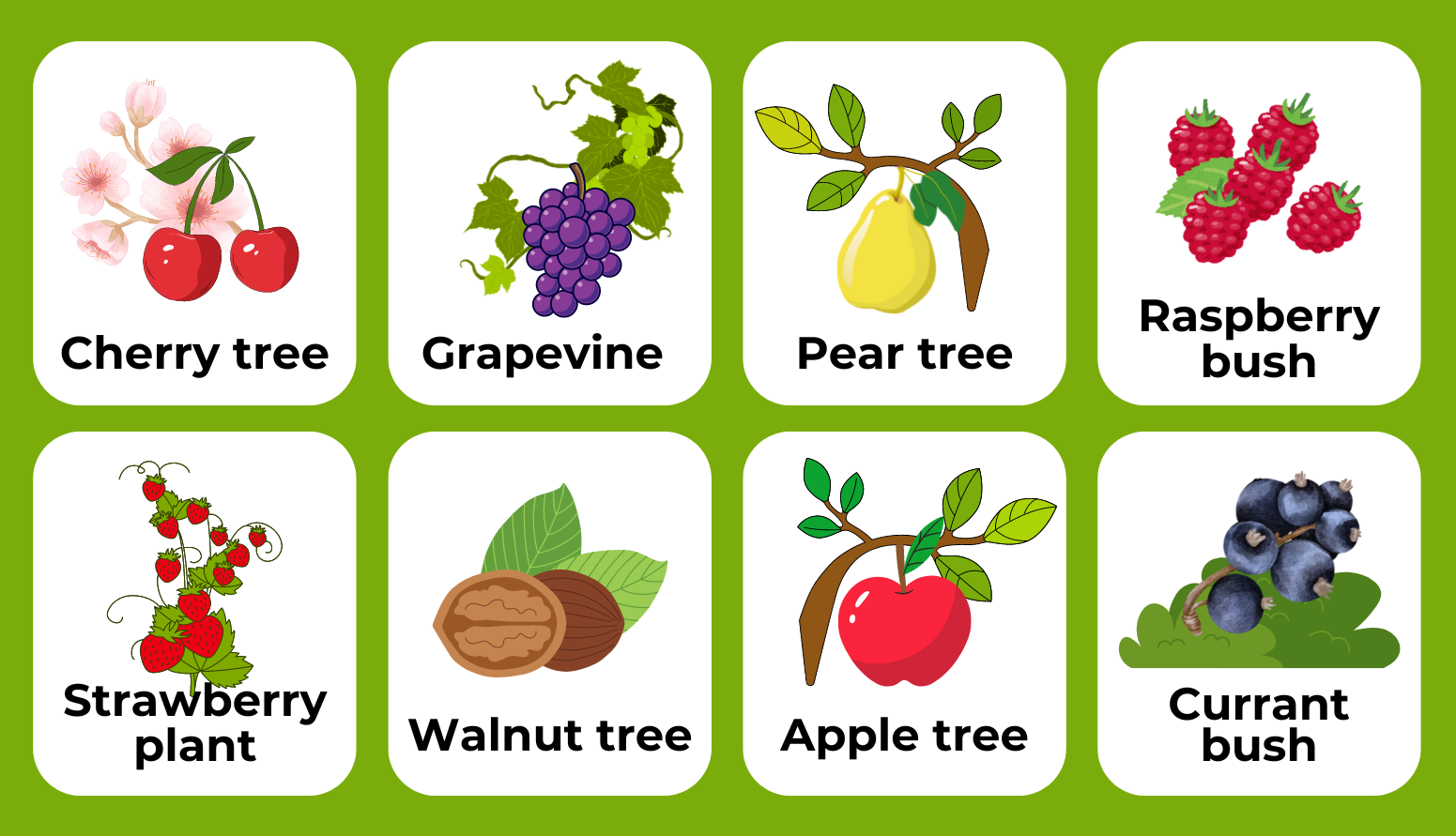Даже если вы не собираетесь поступать в англоязычный университет на ботаника, знать основные виды растений не повредит. С большинством из них мы сталкиваемся каждый день, по крайней мере — регулярно. Цветы растут на клумбах, деревья — в садах и на аллеях, а у многих еще и дома в горшках притаились комнатные растения. Знать хотя бы основные — полезно для общего словарного запаса, да и в жизни пригодится. Вдруг захотите купить маме кактус в горшочке в англоговорящей стране? Или похвалить красивый сад у соседки. Или, быть может, подарить роскошный букет девушке, с которой идете на свидание, но перед этим объяснить флористу, чего бы именно хотелось.

Разница между Plant, Flower и Bloom
Растения в общем смысле этого понятия в английском языке обозначаются словом plants [plænts]. Общее понятие — plants (|plɑːnts|), «растения». Если мы говорим о кусте роз без акцента на том, из чего собираемся сделать букет — это plant. И яблоня, вишня, апельсиновое дерево, кактус, даже торчащая в лесу коряга — все это можно обозначить общим понятием plants («растения вообще»). В научных статьях, книгах можно увидеть именно это слово, причем, неважно, посвящена ли работа фермерству или экологии. Просто в первом случае под plants будет пониматься рожь с пшеницей, а во втором - дождевые леса Амазонки.
Цветы или цветущие растения обозначаются общим словом flowers [ˈflaʊərs]. Это именно «цветы» — то, что мы видим на клумбах, дарим девушкам или мамам на 8 марта. Причем, обычно речь об «одиночных» растениях. То есть, о розах на кусте скажут flowers, но вот если смотреть издалека на цветущее дерево сакуры — или яблони, или абрикоса, — то скорее подойдет понятие «bloom» [bluːm].
Разница в примерах:
Цветы или цветущие растения обозначаются общим словом flowers [ˈflaʊərs]. Это именно «цветы» — то, что мы видим на клумбах, дарим девушкам или мамам на 8 марта. Причем, обычно речь об «одиночных» растениях. То есть, о розах на кусте скажут flowers, но вот если смотреть издалека на цветущее дерево сакуры — или яблони, или абрикоса, — то скорее подойдет понятие «bloom» [bluːm].
Разница в примерах:
- This plant gives flowers every year. «Это растение дает цветы каждый год». То есть, здесь акцент не на самом растении, а на том, что оно цветет, с него можно, вероятно, срезать цветы. Например, так можно сказать о том же кусте роз.
- The cherry tree bloomed. «Вишня расцвела». С нее никто не будет собирать цветочки — хотя бы потому что их очень много, они маленькие, да и вообще вишня ценна скорее ягодами. Но фраза будет говорить о том, что началось такое природное явление.
Поэтому давайте запомним:
- Plant [plænt] — растение в общем смысле этого слова;
- Flower [ˈflaʊər] — цветок (обычно подразумевается одиночное растение);
- Bloom [bluːm] — цветущее дерево.
Названия цветов на английском
Давайте рассмотрим примеры flowers — цветов, которые становятся частью букета, украшают торжественные мероприятия, а иногда и становятся выражением мыслей и чувств.

- Asters [ˈæstərz] - Астры. Asters symbolize elegance and enchantment with their star-shaped blooms.
- Bluebells [ˈbluːˌbɛlz] - Колокольчики. Bluebells create a serene atmosphere with their delicate blue flowers and are often found carpeting woodland floors.
- Carnations [kɑrˈneɪʃənz] - Гвоздики. Carnations symbolize love, fascination, and distinction, and they are frequently used in bouquets and floral arrangements.
- Chrysanthemums [krɪˈsænθəməmz] - Хризантемы. Chrysanthemums are often associated with autumn due to their late-season bloom.
- Clover [ˈkloʊvər] - Клевер. Clover is often associated with good luck and prosperity.
- Chamomiles [ˈkæməˌmɑɪls] - Ромашки.
- Cornflowers [ˈkɔːrnˌflaʊərz] - Васильки. Cornflowers, also known as bachelor's buttons, are charming wildflowers with vibrant blue petals.
- Daffodils [ˈdæfədɪlz] - Нарциссы. Every spring, fields are painted yellow with blooming daffodils.
- Dahlias [ˈdɑːliəz] - Георгины. Dahlias are prized for their diverse colors and intricate petal formations.
- Daisies [ˈdeɪziz] - Маргаритки. Daisies evoke feelings of innocence and simplicity with their cheerful appearance.
- Dandelions [ˈdændɪlaɪənz] - Одуванчики. Dandelions are often considered a symbol of resilience and survival, thriving in various conditions.
- Gerberas [ˈdʒɜːrbərəz] - Герберы. Gerberas are known for their large, daisy-like flowers in a range of bright colors, symbolizing cheerfulness and happiness.
- Hibiscus [hɪˈbɪskəs] - Гибискус. Hibiscus flowers come in various colors and are admired for their tropical beauty, often used in landscaping and as ornamental plants.
- Hyacinths [ˈhaɪəsɪnθs] - Гиацинты. Hyacinths are prized for their sweet fragrance and clustered flowers.
- Jasmine [ˈdʒæzmɪn] - Жасмин. Jasmine is cherished for its intoxicating fragrance and delicate white flowers.
- Lilies [ˈlɪliz] - Лилии. Lilies are known for their elegant and graceful appearance.
- Orchids [ˈɔrkɪdz] - Орхидеи. Orchids are prized for their exotic beauty and intricate designs.
- Peonies [ˈpiːəniz] - Пионы. Peonies are beloved for their large, fluffy blooms and romantic symbolism.
- Poppies [ˈpɑːpiz] - Маки. Poppies symbolize remembrance and consolation, particularly in times of war.
- Roses [ˈroʊzɪz] - Розы. Roses are often given as a symbol of love and affection.
- Sunflowers [ˈsʌnˌflaʊərz] - Подсолнухи. Sunflowers symbolize adoration and loyalty, following the sun's path throughout the day.
- Tulips [ˈtjʊlɪps] - Тюльпаны. Tulips are a symbol of spring and renewal, heralding the end of winter.
- Violets [ˈvaɪəlɪts] - Фиалки. Violets are known for their delicate fragrance and heart-shaped leaves.
Это самые распространенные цветы, которые можно встретить и на клумбах, и в букетах, и даже в горшках у любителей комнатных растений — по крайней мере, фиалки и орхидеи пытаются выращивать дома. Но это все равно flowers.
Садовые растения на английском
Речь идет о деревьях, которые обычно еще и дают плоды. Вишня, груша, яблоня… Они и цветут (bloom), но ценятся не за это. Чаще всего обозначаются сочетанием слов: «название плода + tree |triː| (дерево) или bush |bʊʃ| (куст). Реже — какие-то отдельные понятия, например, vine (лоза), применительно к винограду. Рассмотрим названия садовых растений на английском:

- Almond tree [ˈɑːlmənd triː] - Миндаль. Almond trees produce edible nuts with a mild, sweet flavor that are often eaten raw or used in cooking and baking.
- Apricot tree [ˈeɪprɪˌkɑt triː] - Абрикос. Apricot trees produce velvety-skinned fruit with a sweet and tangy flavor.
- Apple tree [ˈeɪpl triː] - Яблоня.
- Cherry plum tree [ˈʧɛri plʌm triː] - Алыча. Cherry plum trees produce small, cherry-sized fruits that are sweet and flavorful.
- Cherry tree [ˈtʃɛri triː] - Вишня. Cherry trees are known for their beautiful blossoms and tasty fruit.
- Currant bush [ˈkʌrənt bʊʃ] - Смородина. Currant bushes produce clusters of small, tart berries that are commonly used in jams and desserts.
- Grapevine [ˈɡreɪpˌvaɪn] - Виноградная лоза. Grapevines are cultivated for their grapes, which are used for making wine and eaten fresh.
- Gooseberry bush [ˈɡuːsbɛri bʊʃ] - Крыжовник. Gooseberry bushes produce tart berries that are often used in pies and jams.
- Hazelnut tree [ˈheɪzlˌnʌt triː] - Фундук. Hazelnut trees produce small, round nuts with a rich, nutty flavor that are commonly used in confectionery and baking.
- Lemon tree [ˈlɛmən triː] - Лимонное дерево. Lemon trees are valued for their fragrant blossoms and tart fruit.
- Pear tree [pɛər triː] - Груша. Pear trees are prized for their sweet and juicy fruit.
- Peach tree [piːtʃ triː] - Персик. Peach trees are known for their fuzzy fruit with a sweet, juicy flesh.
- Pomegranate tree [ˈpɑːmɪˌɡrænɪt triː] - Гранат. Pomegranate trees produce large, round fruits filled with juicy seeds packed with antioxidants.
- Plum tree [plʌm triː] - Слива. Plum trees produce juicy, sweet fruit that comes in a variety of colors and flavors.
- Raspberry bush [ˈræzˌbɛri bʊʃ] - Малина. Raspberry bushes produce sweet berries throughout the summer.
- Rosehip bush [ˈroʊzˌhɪp bʊʃ] - Шиповник. Rosehip bushes produce bright red or orange fruits that are high in vitamin C and often used in teas and herbal remedies.
- Strawberry plant [ˈstrɔˌbɛri plænt] - Клубника. Strawberry plants produce juicy, sweet berries that are perfect for fresh eating or making preserves.
- Walnut tree [ˈwɔːlnʌt triː] - Орех. Walnut trees produce edible nuts with a rich, buttery flavor that are often used in baking and cooking.
Иногда надо знать, как растет растение, чтобы правильно назвать дерево, кустарник и т.д. Речь об экзотике: cocoa palm (кокосовая пальма) или banana bush (банановый куст) — потому что они именно так и растут.
Декоративные растения на английском
Комнатные растения в английском языке обозначаются словом «houseplants». Но это только о тех, которые стоят на подоконниках, а вот на улице уже снова просто «plants», даже если речь идет о разросшемся алоэ, которое вчера стояло дома. Вот несколько примеров:
Это основные декоративные растения, которые можно найти в саду и доме. Поэтому знать их названия на английском языке полезно. На самом деле, конечно, их гораздо больше, но если не собираетесь на прогулку в ботанический сад, то заучивать необязательно.
- Aloe [ˈæloʊ] - Алоэ. Aloe vera is a popular succulent known for its medicinal properties.
- Cacti [ˈkæktaɪ] - Кактусы. Cacti are known for their ability to store water in arid environments.
- Ferns [fɜːrnz] - Папоротники. Ferns thrive in shady, moist environments such as forests and gardens.
- Ficus [ˈfɪkəs] - Фикус. Ficus plants, also known as fig trees, come in various sizes and varieties and are appreciated for their glossy foliage and air-purifying qualities.
- Fir [fɜːr] - Пихта. During the holiday season, families often decorate a fir tree with lights and ornaments.
- Ivy [ˈaɪvi] - Плющ. Ivy is often used to add a touch of greenery to indoor spaces.
- Juniper [ˈdʒuːnɪpər] - Можжевельник. Juniper berries are sometimes used as a spice in cooking, particularly in flavoring gin.
- Kalanchoe [ˌkæləŋˈkoʊ.iː] - Каланхоэ. Kalanchoe plants are succulents known for their vibrant, long-lasting flowers and thick, fleshy leaves, making them popular indoor and outdoor ornamental plants.
- Lavender [ˈlævəndər] - Лаванда. Lavender plants are known for their fragrant purple flowers and aromatic foliage, making them popular for gardens and as indoor potted plants.
- Peace Lily [ˈpiːs ˈlɪli] - Спатифиллум. The peace lily is a popular indoor plant known for its air-purifying qualities.
- Rubber Plant [ˈrʌbər plænt] - Резерфора. The rubber plant is a low-maintenance houseplant with glossy, dark green leaves.
- Thuja [ˈθuːdʒə] - Туя. A row of Thuja trees provides privacy and creates a natural barrier between properties.
- Violet [ˈvaɪələt] - фиалковое растение. African Violets are small, flowering plants with velvety leaves and colorful blooms, perfect for brightening up windowsills and tabletops.
Это основные декоративные растения, которые можно найти в саду и доме. Поэтому знать их названия на английском языке полезно. На самом деле, конечно, их гораздо больше, но если не собираетесь на прогулку в ботанический сад, то заучивать необязательно.
Учить ботанику в деталях необязательно. Однако понимание основных растений и цветов на английском языке может быть полезным в повседневной жизни. Знание таких слов поможет вам общаться на английском в магазинах и на рынках, а также пригодится при выборе растений для дома, заказе букета в цветочном магазине. Если вы хотите освоить английский язык с учетом этих аспектов, приглашаем вас на курсы английского в школу ULC. Наши преподаватели помогут вам уверенно освоить основы языка, расширить словарный запас и научиться использовать его в повседневных ситуациях.











